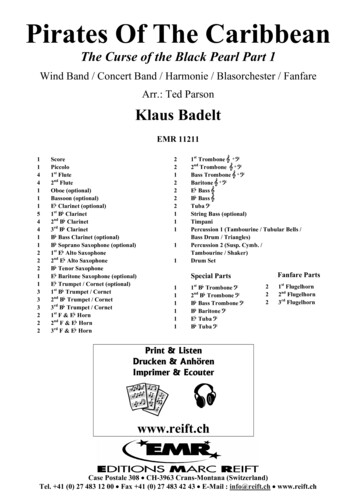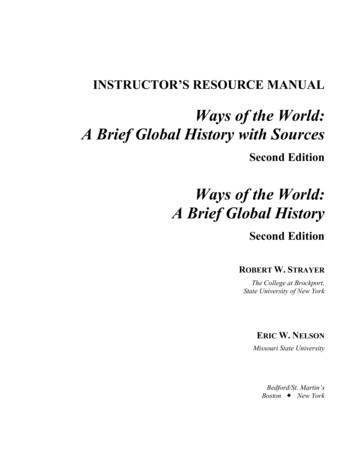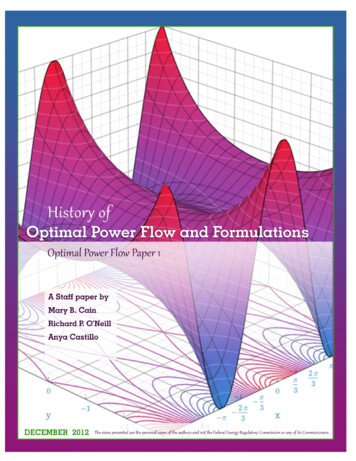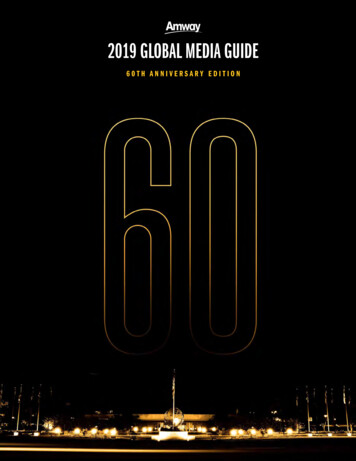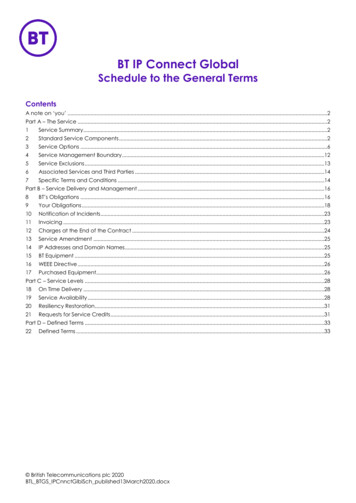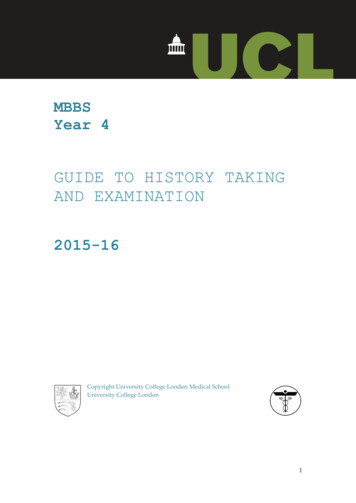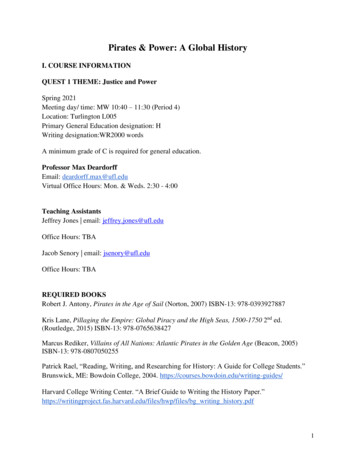
Transcription
Pirates & Power: A Global HistoryI. COURSE INFORMATIONQUEST 1 THEME: Justice and PowerSpring 2021Meeting day/ time: MW 10:40 – 11:30 (Period 4)Location: Turlington L005Primary General Education designation: HWriting designation:WR2000 wordsA minimum grade of C is required for general education.Professor Max DeardorffEmail: deardorff.max@ufl.eduVirtual Office Hours: Mon. & Weds. 2:30 - 4:00Teaching AssistantsJeffrey Jones email: jeffrey.jones@ufl.eduOffice Hours: TBAJacob Senory email: jsenory@ufl.eduOffice Hours: TBAREQUIRED BOOKSRobert J. Antony, Pirates in the Age of Sail (Norton, 2007) ISBN-13: 978-0393927887Kris Lane, Pillaging the Empire: Global Piracy and the High Seas, 1500-1750 2nd ed.(Routledge, 2015) ISBN-13: 978-0765638427Marcus Rediker, Villains of All Nations: Atlantic Pirates in the Golden Age (Beacon, 2005)ISBN-13: 978-0807050255Patrick Rael, “Reading, Writing, and Researching for History: A Guide for College Students.”Brunswick, ME: Bowdoin College, 2004. https://courses.bowdoin.edu/writing-guides/Harvard College Writing Center. “A Brief Guide to Writing the History les/hwp/files/bg writing history.pdf1
Additional documents, articles, and chapters available via Canvas.COURSE DESCRIPTION“Every Man has a Vote in Affairs of Moment; has equal title to the fresh Provisions, or strongLiquors, at any Time seized, and use of them at Pleasure, unless a Scarcity make it necessary, forthe good of all, to Vote a Retrenchment.”In popular imagination, pirates are most often depicted as robbers, murderers, and outlaws whoseviolent actions and plundering challenged established power structures. But as the excerpt above-extracted from the “Articles aboard Capt. Bartholomew Roberts’ Royal Fortune”*-demonstrates, pirates abided by their own set of morals and rules. While their exterior actionsclearly conflicted with habitual definitions of justice (such as the laws of empires, internationallaw, etc.), an examination of the ulterior logic behind pirates’ actions and their socialorganization reveals alternative understandings of justice and uncovers particular powerdynamics within pirate communities. This course therefore raises a series of questions around theroles that justice and power played in shaping pirate communities and their actions across timeand space. What motivated men and women to engage in pirate activities? Were pirates pariahs,or were they vigilantes seeking justice against tyrant monarchs? Can pirate crews be classified asdemocratic? What are the similarities and differences between those classified as pirates duringthe “Golden Age of Piracy,” and contemporary pirate-like activities off the coast of East Africa?And to what extent is it accurate to use the term “piracy” to describe contemporary phenomenathat circumvent copyrights and membership fees, such as online streaming and file sharing(Torrent, Sci-Hub, etc.)? This course examines these questions in a global framework, from theAncient World to our own contemporary times.*“Articles aboard Capt. Bartholomew Roberts’ Royal Fortune” (1720) in: Robert J. Antony,Pirates in the Age of Sail (Norton, 2007), 92.II. COURSEWORK AND ate a map from a word bank(precision and creativity will berewarded). Assmt. 1: Ancient World &Mediterranean; Assmt. 2: Atlantic World;Assmt. 3: Indian OceanRequirementsPoints3x32
Primary SourceAnalyses (x2)Read and evaluate primary course(specific prompt to be distributed inclass)Tests (x2)In-class test consisting of a combinationof IDs, short answers, and essay.Active ReadingJournalSummarize and respond to assignedweekly readingsCapstoneProject –AnalyticalEssayEach student will select a work of fiction(novel, movie, TV show) and analyze itin light of the semester-long interactionswith readings and materials in SpecialCollections. (Discussion sectionsthroughout semester prepare students byengaging literary and visual materials i.e. short clips from popular movies,cartoons, paintings, etc.) Guidingquestions for the assignment: How arepirates depicted in popular culture? Whatstereotypes are propagated in thesefictional representations? To what extentdo representations align with and departfrom historical realities?ParticipationActively engage in class discussion andother in-class activities (small-groupexercises, etc.)AttendanceAttend lectures and discussion sectionsregularly and ready to engage with thematerial, the professor, the TA, and yourpeers500 licies for thiscourse52. Weekly Course ScheduleWeek 1. Introduction - Defining PiracyMon 1/11, Wed 1/13, Fri 1/15Read: Rediker, Villains of All Nations, ch. 1, 1-18Lane & Bialuschewski, “Global Piracy and European Law,” in Piracy in theEarly Modern Era, 1-83
UNIT 1: POWER IMBALANCES: CONFLICT on the MEDITERRANEANWeek 2. Piracy in Ancient Greece and RomeMon 1/18 MLK DAY, Wed 1/20, Fri 1/22Read: Souza, Piracy in the Graeco-Roman World, 1-14*Map Quiz 1, in class (10 minutes) on Wednesday, 1/20Week 3. Pirates and Corsairs in the Sixteenth-Century MediterraneanMon 1/25, Wed 1/27, Fri 1/29Read: Lane, Pillaging the Empire, ch. 1, 11-32*Primary Source Analysis 1 due Friday 1/29Week 4. Portugal, Spain, and the Rise of Global EmpiresMon 2/1, Wed 2/3, Fri 2/5Read: Lane, “Potosí Mines,” 1-15Elliott, “Empire and Identity,” ch. 8 in Empires of the Atlantic World, 219-251Columbus, “Memorandum to Antonio de Torres, Isabela, 30 January 1494” inColumbus on Himself, 115-127“Episode 81: The Trans Pacific Silver Trade and Early-ModernGlobalization” at 15 Minute HistoryUNIT 2: POWER and JUSTICE in the AGE of ATLANTIC EMPIRESWeek 5. Smugglers, Pirates, and Privateers: The ElizabethansMon 2/8, Wed 2/10, Fri 2/12Read: Lane, Pillaging the Empire, ch. 2, 33-61*Map Quiz 2, in class (10 minutes) on Wednesday, 2/10Week 6. Case Study in Early Modern Globalization – The World of Francis DrakeMon 2/15, Wed 2/17, Fri 2/19Read: Antony, Pirates in the Ages of Sail, 61-64, 143-146Kelsey, Sir Francis Drake: The Queen’s Pirate, xv-xviii*Test 1 - In class on Friday, 2/19Week 7. The Fight for Netherlands Independence and the birth of the Dutch Sea RoversMon 2/22, Wed 2/24, Fri 2/264
Read: Lane, Pillaging the Empire, ch. 3, 62-95*Students visit Special Collections with their sections on Friday 2/26Week 8. Buccaneers of the Seventeenth-Century CaribbeanMon 3/1, Wed 3/3, Fri 3/5Read: Lane, Pillaging the Empire, ch. 4, 96-130UNIT 3: REGIMES of (IN)JUSTICE on the HIGH SEASWeek 9. Economics and Ideology (On Contraband, Free Trade, and Egalitarianism)Mon 3/8, Wed 3/10, Fri 3/12Read: Rediker, Villains of All Nations, ch. 4-5, 60-102*Map Quiz 3, in class (10 minutes) on Wednesday, 3/10*Hand in Active reading journal for initial checkWeek 10. Life, Labor, (and Love?) on Ship and in PortMon 3/15, Wed 3/17, Fri 3/19Read: Rediker, Villains of All Nations, ch. 3 & 6, 38-59 & 103-126*Primary Source Analysis 2 due Friday 3/19Week 11. The Golden Age of Piracy in the AtlanticMon 3/22, Wed 3/24, Fri 3/26Read: Rediker, Villains of All Nations, ch. 7, 127-147Lane, Pillaging the Empire, ch. 6, 164-197Bialuschewski, “Black People under the Black Flag: Piracy and the Slave Tradeon the West Coast of Africa, 1718-1723” Slavery & Abolition 29, no. 4 (2008):461-475.Week 12. Pirates in Popular CultureMon 3/29, Wed 3/31, Fri 4/2Read: Rediker, Villains of All Nations, ch. 8, conclusion, 147-177UNIT 4: POWER CONVERGENCES in the INDIAN OCEANWeek 13. Three Great Waves: Piracy on the China CoastMon 4/5, Wed 4/7, Fri 4/95
Read: Antony, Pirates in the Age of Sail, I. iv, 32-43Murray, “Cheng I Sao in Fact and Fiction,” in Bandits at Sea: A Pirates Reader,253-282*Test 2 - In class on Friday 4/9Week 14. Raiders, Warriors, and Traders in Southeast AsiaMon 4/12, Wed 4/14, Fri 4/16Read: Antony, Pirates in the Age of Sail, I.v, 44-55Prange, “A Trade of No Dishonor: Piracy, Commerce, and Community in theWestern Indian Ocean, Twelfth to Sixteenth Century,” American HistoricalReview 116, no. 5 (2011): 1269-1293.*Turn in reading journal for final checkWeek 15. Global Piracy TodayMon 4/19, Wed 4/21, Fri 4/23 READING DAYRead: Antony, Pirates in the Age of Sail, I. vi, 56-59Alpers, “Piracy and Indian Ocean Africa,” Journal of African Development 13,no. 1 (2011): 17-38.Documentary: Stolen Seas (2013).*Capstone Project Due 4/26III. GRADINGStatement on Attendance and ParticipationAttendance and Participation:Requirements for class attendance and make-up exams, assignments, and other work in thiscourse are consistent with university policies that can be found ns/attendance-policies/Attendance (5 points) is required; students are permitted three discretionary, unexcusedabsences without penalty. Further absences require official documentation, otherwise one pointwill be deducted for each unexcused absence. Poor attendance (40% or more of the semester) isgrounds for failing the course.Classroom Mask Policy: Effective until the whole Gainesville community hasreceived vaccinations against COVID-19, all students who attend class in-6
person are required to wear a mask that covers mouth and nose from thetime they enter the classroom until they leave it. There will be a zero-tolerancepolicy. If any student enters the classroom without a mask or removes a maskwhile in the classroom, the student will be assumed to be an asymptomaticcarrier of COVID-19 and the in-class meeting will be cancelled immediately.Furthermore, to avoid spread of contamination, the whole class willundertake a two-week (14 days) quarantine period, in which all instructionwill move online. Only after completion of the quarantine period will in-personclasses resume. No due dates for assignments will be changed because of the shiftto virtual learning during the quarantine, and students will be responsible for allmaterial in the cancelled class period. If any student enrolled for in-personsections has trouble finding a mask on class day, that student should avoidattending in-person and should instead attend d-physical-distancing/Class participation (10 points) includes: completion of assigned reading and consistent,informed, thoughtful, attentive courteous and professional engagement with class materials,fellow students and instructor/TA in class and/or office hours. Consistent high-quality classparticipation—in large and small groups—is expected. “High-quality” in this case means:informed (i.e., shows evidence of having done assigned work); thoughtful (i.e., shows evidenceof having understood and considered issues raised in readings and other discussions), andconsiderate (i.e., takes the perspectives of others into account).If you have personal issues that prohibit you from joining freely in class discussion, e.g.,shyness, language barriers, etc., see the instructor as soon as possible to discuss alternativemodes of participation.Participation Grading RubricHigh QualityAverageNeeds ImprovementInformed: Showsevidence of having donethe assigned work.Thoughtful: Showsevidence of havingunderstood andconsidered issues raised.7
Considerate: Takes theperspective others intoaccount.WR Statements and Grading RubricFor courses that confer WR credit, the course grades have two components:To receive writing credit, 1) a student must receive a grade of “C” or higher, and 2) you mustturn in all essays totaling 2,000 words to receive credit for writing 2,000 words. The writingrequirement ensures students both maintain their fluency in writing and use writing as a tool tofacilitate learning.PLEASE NOTE: a grade of “C-” will not confer credit for the University Writing Requirement.The instructor and/or Teaching Assistants will evaluate and provide feedback on the student'swritten assignments with respect to content, organization and coherence, argument and support,style, clarity, grammar, punctuation, and mechanics. Conferring credit for the University WritingRequirement, this course requires that essays conform to the following assessment rubric. Morespecific rubrics and guidelines applicable to individual assignments may be delivered during thecourse of the semester.The instructor and/or Teaching Assistants will assess feedback andprovide suggestions for improvement by the time of the second writing assignment. Foradditional assistance with writing, take advantage of the writing studio: writing@ufl.edu, at 2215Turlington.WRITING tualizes the topicin a way that addressesthe prompt.Equal analysis ofall portions of theprompt. Essayprovides crisp andinsightfulassessment of theevidence, andclearly connects theprimary source tothe week’s topicand readings.Logicallyorganized and easyto follow.Paragraphs areunited by topicsentences that arerelevant, accurate,and specificLays out clearly whatthe essay willaccomplish, andanticipates the overallconclusion.Includes a detailedorganizational statementguiding the reader.Clarity and StyleVirtually nogrammar/spellingmistakes.Style is crisp andeloquent.Correct use of foreignwords and wordsfrom other historicalperiods.8
BThe Introduction eithercontextualizes the topicto which the promptrelates, OR it points tothe main insights thereader will gain fromreading this essay.Thoroughlyexplains andanalyzes relevantevidence.Addresses most(but not all) pointslaid out in theinstructions.Most paragraphshave topicsentences that areaccurate, andcontain analysis.CThe introductiondirectly addresses thequestions noted on theassignment’sinstructions, in a directanswer style rather thanan essay format. It maynot provide a broaderintroduction to the topicat hand. Introductionmay imperfectlycommunicate specifictime and place.Some relevantexplanation andanalysis, butinsufficientconnection to theweek’s topic andreadings.EITHERexhibiting clearorganizationalpattern but no/fewtopic sentences,OR topicsentences, but oneslacking analysis orspecificity. Maystray fromorganizationalpattern.DThe introduction doesnot give the reader aclear idea of the purposeof the essay, and fails tocontextualize the topicat hand.Analysis isirregular orgenerally lacking.EThere is no introductionMay containaccurate statements,but no analysis(failing)Topic sentences areattempted but aresometimes unclear,OR do not clearlyanswer respond tothe promptNo attempt toformat as essay.Smallgrammar/spellingmistakes. Anoccasional word ismisused.Essay format partiallyor not achieved.Despite repeatedgrammar/spellingerrors, writing is stillrelatively clear.Several words mayhave been misused.Paper is full ofgrammatical errorsthat may hindercomprehension.Several words mayhave been misused.Paper is full ofgrammatical errorsthat hindercomprehension.Several words mayhave been misused.Grading ScaleFor information on how UF assigns grade points, visit: rades-grading-policies/9
A94 – 100% ofpossible pointsC74 – 76%A-90 – 93%C-70 – 73%B 87 – 89%D 67 – 69%B84 – 86%D64 – 66%B-80 – 83%D-60 – 63%C 77 – 79%E 60IV. QUEST LEARNING EXPERIENCESExperiential Learning ComponentStudents will spend a class session working with the librarians and curators in UF’s SpecialCollections and Map and Imagery Library. They will be introduced to and examine pirate-relatedmaterials such as treasure maps, performance programs (Performing Arts and Popular CultureCollections), pirate chronicles (the Florida Literature section), and children’s books (BaldwinLibrary). These items will be considered in light of historical documents from the FloridaHistory Collection and Manuscripts Collection. Students will use the opportunity to gathermaterial for their Capstone Project and be required to complete a directed entry for their ActiveReading Journals.[Note: faculty in the Department of History are in conversation with the librarians about usingthis course to create a WordPress site on the theme of Pirates and Piracy: Myths and Realitieswith student group contributions for images, blog entries, etc. The feasibility of this project willdepend in part on the number of students in the class.]Self-Reflection Component: Active Reading JournalAccording to historian Mary Lynn Rampolla, author of A Pocket Guide to Writing in History:“To do your best work in history, you need to become an active reader. In contrast to passivereaders, active readers are engaged in a dialogue with the text. They ask questions, makecomments, and connect what they are reading to information they already know and texts they10
have already read. This kind of careful and critical reading is crucial both for active andintelligent participation in class discussion and for writing effective papers.”Students will keep an Active Reading Journal for the semester. For some weeks, they will begiven prompts based on the assigned readings and the week’s topics; for others, they will be ableto determine the nature of their entries. On occasion, the responses will be completed in sectionsin conjunction with discussions. Completion of the journal will allow you to: Keep up with the weekly reading Engage in a dialogue with the course materials, exploring what you think and why youthink it Pose questions, explore new ideas, make connections across the reading Relate course materials, discussions, etc. to current events, your own experiences, andyour intellectual developmentGrading criteria: While this is a writing exercise and your expression needs to be clear, thejournal will not be graded according to the formal writing rubric (see above). Rather, it will begraded in terms of your on-time submission, thoroughness, and level of engagement. Journalentries will not count toward the 2,000 word writing requirement.V. General Education and Quest Objectives & SLOsThis Course’s Objectives—Gen Ed Primary Area and QuestHumanitiesObjectivesHumanities coursesprovide instruction inthe history, key themes,principles,terminology, andtheory ormethodologies usedwithin a humanitiesdiscipline or thehumanities in general.Quest 1 ObjectivesAddress the history, keythemes, principles,terminologies, theories,and methodologies ofvarious arts andhumanities disciplinesthat enable us to askessential questions aboutthe human condition.This Course’sObjectivesObjectives will beAccomplished By:(This course will .)(This course willaccomplish theobjective in the box atleft by )Explore the long andcomplex history of globalpiracy and privateering,examining the role ofthese activities in thebuilding of imperialpower structures and theconstruction ofcompeting legal regimes.Examining a variety ofprimary and secondarysource readings, worksof fiction, films, andtelevision shows.11
Students will learn toidentify and to analyzethe key elements,biases and influencesthat shape thought.These coursesemphasize clear andeffective analysis andapproach issues andproblems from multipleperspectives.Present different arts andhumanities disciplines’distinctive elements,along with their biasesand influences onessential questions aboutthe human condition.Introduce students to howknowledge is producedand how historiansinterpret the past; useliterary and visualanalysis to explorerepresentations of piracy,past and present; conductanalysis of lawsconcerning piracy;examine historicalmanifestations of piratesociology.Close and guidedreading of, discussion of,and writing abouthistorical, literary, visual,and legal sources.Explore at least one artsor humanities resourceoutside their classroomand explain howengagement with itcomplements classroomwork.Expose students toprimary sources in UF’sLibrary and SpecialCollections and the waysin whichlibrarians/archivists andhistorians work togetherto preserve, chronicle,and interpret the past.Taking students toLibrary East where theywill meet with librariansand archivists and studypirate-related items fromthe University’scollections.Enable students toanalyze and evaluatees
6 Read: Antony, Pirates in the Age of Sail, I. iv, 32-43 Murray, “Cheng I Sao in Fact and Fiction,” in Bandits at Sea: A Pirates Reader, 253-282 *Test 2 - In class on Friday 4/9 Week 14. Raiders, Warriors, and Traders in Southeast Asia Mon 4/12, Wed 4/14, Fri 4/16 Read: Antony, Pirates in the Age of Sail, I.v, 44-55 Prange, “A Tra
